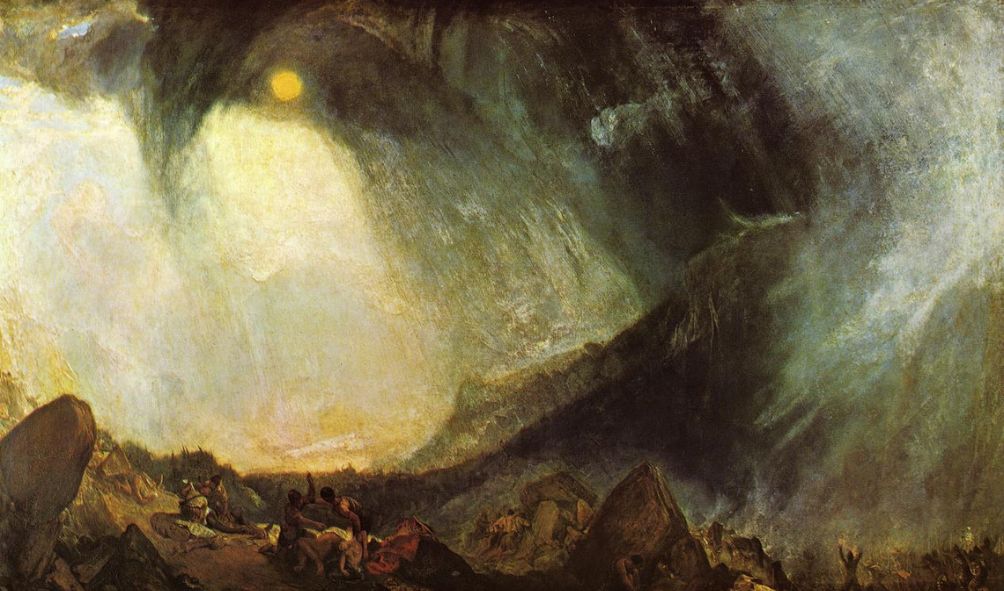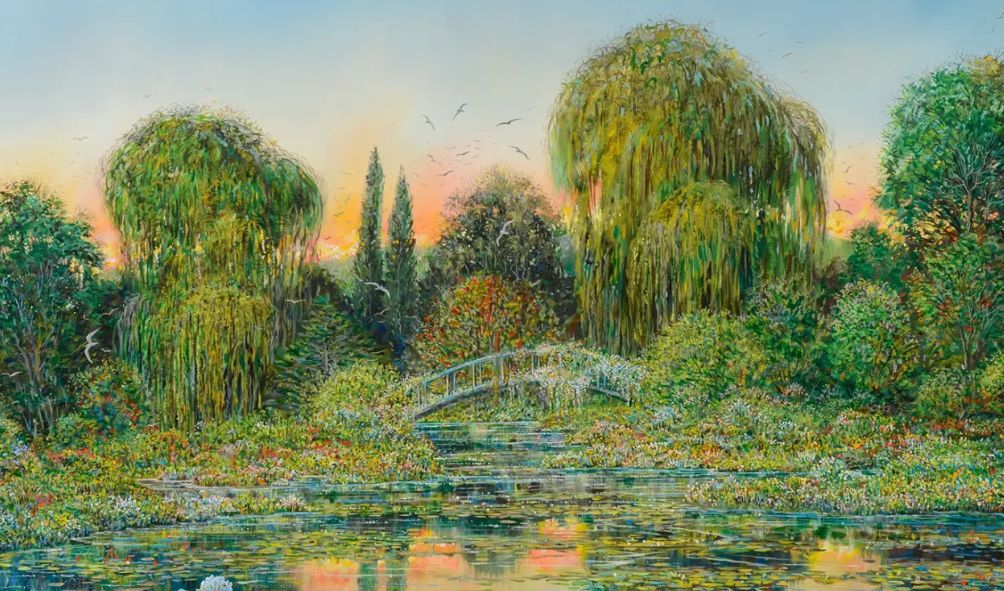Landscape paintings by famous artists represent a captivating journey through art history, revealing evolving styles and techniques across centuries. From the Romantic era’s dramatic depictions of nature to the Impressionists’ fleeting moments of light and color, and the Post-Impressionists’ exploration of personal expression within landscapes, the evolution of this genre is a testament to artistic innovation. This exploration delves into the lives and works of renowned landscape painters, analyzing their unique approaches and the enduring impact their masterpieces have had on art and culture.
We will examine how geographical locations influenced artistic styles, exploring the distinct characteristics of paintings from diverse regions. The analysis will encompass the social and cultural contexts surrounding the creation of these works, demonstrating how landscape paintings reflected and shaped the prevailing ideologies and values of their respective eras. By studying the techniques, themes, and historical significance of landscape paintings, we gain a deeper understanding of both the artistic process and the broader cultural landscape they inhabit.
Defining Landscape Painting Styles
Landscape painting, far from being a static genre, has undergone a dramatic evolution, reflecting changing artistic sensibilities and societal perspectives across centuries. Its development is a fascinating journey mirroring the interplay between artistic innovation and the ever-shifting relationship between humanity and the natural world.
The Evolution of Landscape Painting
Early landscape painting, often found as background elements in religious or mythological scenes during the Renaissance, gradually gained prominence. Northern European artists, particularly during the 16th and 17th centuries, began to explore landscape as a subject in its own right. Artists like Albrecht Altdorfer and Pieter Bruegel the Elder created detailed and atmospheric landscapes, often imbued with a sense of human activity within the natural environment. The 17th-century Dutch Golden Age saw a flourishing of landscape painting, with artists like Jacob van Ruisdael and Meindert Hobbema focusing on the meticulous depiction of Dutch countryside, often emphasizing light and atmospheric effects. This detailed realism paved the way for subsequent movements.
Romantic, Impressionistic, and Post-Impressionistic Landscapes: A Comparison
Romantic landscape painting, emerging in the late 18th and early 19th centuries, emphasized the sublime power and emotional impact of nature. Artists like Caspar David Friedrich and J.M.W. Turner used dramatic lighting, vast scale, and evocative imagery to convey a sense of awe, mystery, and even terror in the face of the natural world. In contrast, Impressionism, developing in the late 19th century, focused on capturing the fleeting effects of light and atmosphere. Artists such as Claude Monet and Camille Pissarro employed short, broken brushstrokes and vibrant colors to depict the sensory experience of nature, prioritizing immediate perception over detailed representation. Post-Impressionism, building upon Impressionism, saw artists like Vincent van Gogh and Paul Cézanne explore more subjective and expressive approaches to landscape painting. Van Gogh’s swirling brushstrokes and intensely emotional color palettes convey a personal response to nature, while Cézanne’s structured compositions and exploration of form laid the groundwork for modern art.
Geographical Influences on Landscape Painting Styles
The physical geography of a region profoundly influenced the development of its unique landscape painting styles. The dramatic mountains and rugged coastline of the Alps, for instance, inspired the Romantic landscapes of artists like Caspar David Friedrich, who conveyed the sublime power and spiritual significance of the landscape. The flat, open spaces of the Dutch countryside, with its intricate network of canals and windmills, shaped the detailed realism of Dutch Golden Age landscape painting. Similarly, the Mediterranean light and the vibrant colors of the French countryside informed the Impressionist movement, with artists capturing the fleeting beauty of sunlight on water and foliage.
| Period | Style | Key Characteristics | Representative Artists |
|---|---|---|---|
| Renaissance | Early Landscape (as background) | Often symbolic, serving as a setting for religious or mythological scenes. | Leonardo da Vinci, Raphael |
| 16th-17th Centuries (Northern Europe) | Detailed Realism | Precise rendering of detail, atmospheric perspective, focus on human activity within the landscape. | Albrecht Altdorfer, Pieter Bruegel the Elder |
| 17th Century (Dutch Golden Age) | Dutch Landscape | Meticulous detail, focus on light and atmospheric effects, depiction of Dutch countryside. | Jacob van Ruisdael, Meindert Hobbema |
| Late 18th – Early 19th Centuries | Romanticism | Emphasis on the sublime, dramatic lighting, emotional impact, vast scale. | Caspar David Friedrich, J.M.W. Turner |
| Late 19th Century | Impressionism | Focus on light and atmosphere, short broken brushstrokes, vibrant colors, fleeting moments. | Claude Monet, Camille Pissarro |
| Late 19th Century | Post-Impressionism | Subjective expression, exploration of form and color, personal response to nature. | Vincent van Gogh, Paul Cézanne |
Landscape Paintings by Famous Artists and Their Techniques
Landscape painting, a genre depicting natural scenery, has captivated artists for centuries. From the serene pastoral scenes of the Dutch Golden Age to the dramatic, emotionally charged landscapes of the Romantics, the artistic approaches and techniques employed have been incredibly diverse, reflecting both the artist’s individual style and the prevailing artistic movements of their time. This section explores the lives and artistic techniques of five renowned landscape painters, examining their unique contributions to the genre.
Claude Monet and Impressionism
Claude Monet (1840-1926), a pivotal figure in Impressionism, revolutionized landscape painting through his emphasis on capturing the fleeting effects of light and atmosphere. His technique involved applying short, broken brushstrokes of pure, unmixed color directly onto the canvas, allowing the viewer’s eye to blend the colors optically. His color palettes were vibrant and often shifted dramatically depending on the time of day and weather conditions. Monet’s recurring themes centered on the natural world, particularly water lilies, haystacks, and the Rouen Cathedral, which he painted repeatedly under varying light conditions.
- Impression, soleil levant (Impression, Sunrise): This painting, which gave the Impressionist movement its name, depicts the hazy atmosphere of a sunrise over the port of Le Havre, showcasing Monet’s masterful use of light and color.
- Water Lilies series: This extensive series of paintings showcases Monet’s fascination with the reflections and interplay of light on water, creating a sense of tranquility and immersive beauty. The large-scale canvases and almost abstract application of color are characteristic of his later work.
- Haystacks series: This series, like the Water Lilies, demonstrates Monet’s commitment to capturing the subtle changes in light and atmosphere throughout the day, highlighting the transient nature of the landscape.
Caspar David Friedrich and Romanticism

Caspar David Friedrich (1774-1840), a leading figure in German Romanticism, imbued his landscapes with a profound sense of mystery and spirituality. His meticulous detail and precise brushwork contrast with the emotional intensity of his compositions. Friedrich favored a relatively muted color palette, often using deep blues, greens, and browns to create a sense of awe and reverence for nature. Recurring themes in his work include the sublime power of nature, the contemplation of mortality, and the search for spiritual meaning in the natural world.
- Wanderer above the Sea of Fog: This iconic painting depicts a solitary figure gazing out over a vast expanse of fog-shrouded landscape, symbolizing the individual’s confrontation with the sublime and the unknown.
- Chalk Cliffs on Rügen: This dramatic landscape showcases Friedrich’s skill in depicting the power and grandeur of nature, emphasizing the vastness of the sea and the dramatic cliffs.
- Two Men Contemplating the Moon: This painting highlights the Romantic interest in introspection and the search for spiritual meaning, with two figures contemplating the moonlit landscape.
J.M.W. Turner and Sublime Landscapes

J.M.W. Turner (1775-1851) was a master of capturing the dramatic effects of light and weather in his landscapes. His technique was characterized by loose, energetic brushstrokes and a vibrant, often almost abstract use of color. He frequently employed impasto, applying thick layers of paint to create texture and movement. Turner’s color palettes were rich and varied, reflecting the intensity of the natural world. Recurring themes in his work include the sublime power of nature, the dynamism of the sea, and the fleeting beauty of light and atmosphere.
- The Fighting Temeraire tugged to her last Berth to be broken up, 1838: This iconic painting depicts a decommissioned warship being towed to its final resting place, symbolizing the passage of time and the transience of human endeavor against the backdrop of a powerful and awe-inspiring landscape.
- Rain, Steam, and Speed – The Great Western Railway: This painting captures the dynamism of the Industrial Revolution, contrasting the power of the train with the dramatic force of nature.
- Snow Storm – Hannibal and his Army crossing the Alps: This painting showcases Turner’s ability to depict the ferocity of a snowstorm, creating a sense of chaos and drama.
John Constable and Pastoral Romanticism

John Constable (1776-1837) is renowned for his idyllic depictions of the English countryside. His technique involved meticulous observation of nature, using precise brushstrokes to render the details of foliage, clouds, and water. While he employed a relatively restrained palette, his use of light and shadow created a sense of depth and atmosphere. Recurring themes in his work include the beauty of the English countryside, the importance of observing nature, and the idyllic life of rural communities.
- The Hay Wain: This iconic painting depicts a quintessential English rural scene, showcasing Constable’s mastery of light and shadow and his detailed rendering of nature.
- Salisbury Cathedral from the Meadows: This painting exemplifies Constable’s ability to capture the subtle interplay of light and atmosphere, creating a serene and contemplative mood.
- Wivenhoe Park: This painting showcases Constable’s skill in depicting the beauty of the English landscape, emphasizing the tranquility and charm of the rural setting.
Thomas Gainsborough and Eighteenth-Century Landscape
Thomas Gainsborough (1727-1788) was a master of 18th-century landscape painting, known for his elegant compositions and delicate brushwork. His technique involved a balance between detail and suggestion, capturing the essence of the scene rather than every minute detail. His color palettes were often light and airy, reflecting the refined sensibility of his time. Recurring themes in his works include the picturesque beauty of the English countryside, idealized pastoral scenes, and the integration of figures within the landscape to enhance the narrative.
- The Harvest Waggon: This painting showcases Gainsborough’s ability to capture the beauty of the English countryside, with a focus on the idyllic aspects of rural life.
- Cornard Wood: This painting demonstrates Gainsborough’s skill in depicting the rich textures and varied colors of woodland scenes.
- Landscape with a Ruined Arch: This painting showcases Gainsborough’s use of classical elements within a landscape setting, creating a sense of harmony and balance.
Analyzing the Impact of Landscape Paintings
Landscape painting, far from being a mere depiction of nature, has profoundly shaped societal perceptions, cultural values, and national identities throughout history. These paintings served as powerful tools for expressing prevailing ideologies, reflecting social changes, and even fostering a sense of collective belonging. Their impact extends beyond the artistic realm, influencing everything from tourism and environmental awareness to the very way we understand and interact with the natural world.
Landscape paintings reflected the prevailing ideologies and values of different eras by subtly, and sometimes overtly, incorporating the dominant philosophical and social currents of their time. For example, the serene and idealized landscapes of the Romantic era contrasted sharply with the more realistic and often melancholic depictions of the Industrial Revolution. This shift in artistic style mirrored the broader societal anxieties and transformations occurring at the time.
The Social and Cultural Impact of Landscape Paintings Throughout History
Landscape paintings have served various social and cultural functions across different periods. In the 17th and 18th centuries, aristocratic patrons commissioned grand landscapes showcasing their estates and power, projecting an image of wealth and land ownership. Conversely, the rise of Romanticism saw landscapes used to express emotional states, connecting the viewer with the sublime power of nature and fostering a sense of awe and wonder. The later development of plein air painting democratized the landscape genre somewhat, making it more accessible to a wider audience and allowing for a more direct engagement with the natural world. This led to the development of a stronger appreciation for nature and its conservation.
Landscape Paintings as Reflections of Ideologies and Values
The styles and subjects of landscape paintings frequently mirrored the prevailing beliefs and values of their respective eras. The classical landscapes of the Renaissance emphasized order, harmony, and idealized forms, reflecting the humanist ideals of the time. In contrast, the dramatic and often turbulent landscapes of the Romantic period reflected the emotional intensity and fascination with the untamed power of nature characteristic of that era. The rise of Impressionism saw a shift towards a more subjective and immediate representation of nature, reflecting the changing artistic sensibilities of the late 19th century. The stark and often desolate landscapes of 20th-century movements like Expressionism or Surrealism reflected the anxieties and uncertainties of a world grappling with war and social upheaval.
Landscape Paintings and the Development of National Identities
Landscape paintings have played a crucial role in shaping national identities. The Hudson River School in the United States, for example, created idealized landscapes of the American wilderness, contributing to the development of a distinct American artistic identity and fostering a sense of national pride and belonging. Similarly, the Barbizon School in France depicted the rural landscapes of the country, helping to solidify a particular image of French national identity. These paintings often served as powerful symbols of national heritage and cultural identity, reinforcing a sense of place and belonging for citizens.
Landscape Paintings and Artistic Movements
The development of landscape painting has been intrinsically linked to various artistic movements. The Renaissance saw the emergence of landscape as an independent genre, distinct from religious or historical painting. The Baroque period featured dramatic landscapes that mirrored the grandeur and theatricality of the era. Romanticism elevated landscape painting to a position of high artistic importance, emphasizing emotion and the sublime aspects of nature. Impressionism revolutionized landscape painting with its focus on light, color, and fleeting moments. Later movements like Post-Impressionism, Expressionism, and Surrealism further explored the expressive and symbolic potential of landscape painting.
| Era | Social Context | Artistic Movement | Impact on Society |
|---|---|---|---|
| Renaissance | Humanism, burgeoning scientific inquiry, growing wealth and power of city-states | Early Renaissance, High Renaissance | Established landscape as an independent genre; reflected humanist ideals of order and harmony; promoted idealized views of nature. |
| 17th-18th Centuries | Aristocratic patronage, colonial expansion, Enlightenment ideals | Dutch Golden Age, Baroque | Landscapes became symbols of wealth and power; depictions of idealized landscapes reflected aristocratic tastes; colonial landscapes showcased newly acquired territories. |
| Romantic Era (late 18th – 19th Centuries) | Industrial Revolution, rise of nationalism, focus on emotion and the sublime | Romanticism, Hudson River School (US) | Elevated landscape painting to high artistic status; expressed emotional responses to nature; fostered a sense of national pride and belonging (especially in the US); promoted a growing appreciation for wilderness. |
| Late 19th – Early 20th Centuries | Industrialization, urbanization, rapid social and technological change | Impressionism, Post-Impressionism, Expressionism | Revolutionized landscape painting techniques; explored subjective perspectives on nature; reflected anxieties and uncertainties of a rapidly changing world; paved the way for modern and abstract art. |
End of Discussion
In conclusion, the exploration of landscape paintings by famous artists unveils a rich tapestry of artistic expression and cultural significance. From the technical mastery of brushstrokes and color palettes to the profound social and historical contexts in which these works were created, the journey through this genre reveals not only the artists’ individual genius but also the enduring power of art to reflect and shape human experience. The enduring appeal of landscape painting lies in its ability to connect viewers with the natural world, evoking emotions and prompting reflection on the relationship between humanity and the environment. The legacy of these artists continues to inspire and challenge artists today, ensuring the enduring relevance of landscape painting as a vital art form.
Read More:
- Famous Artists Paintings: A Concise Overview
- Black Artist Paintings: A Best Visual History
- Passive Income for Artists: Unlocking Financial Freedom

